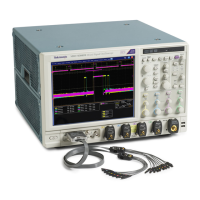Commands Listed in Alphabetical Order
MATH<x>? (Que
ry Only)
This query-only command returns the definition for the math waveform specified
by <x>, which ranges from 1 through 4.
Group
Math
Syntax
MATH<x>?
Related Commands
SELect:<wfm>
Examples
MATH1? might return the following definition of a math
waveform:
:MATH1:DEFINE "Ch1-Ch2";UNITSTRING "V";
NUMAVG 2;VERTICAL:SCALE 112.0000E-3; POSITION
1.6400;:MATH1:LABEL:NAME "";XPOS 1.0000;YPOS
600.0000E-3;:MATH1:SPECTR AL:MAG DB;PHASE DEGREES;GATEPOS
0.0000;GATEWIDTH 4.0000E-6;REFLEVEL 20.0000;REFLEVELOFFSET
223.6000E-3;SPAN 625.0000E+6;CENTER 312.5000E+6;RESBW
500.0000E+3;WINDOW GAUSSIAN;SUPPRES S -200.0000;UNWRAP 0;LOCK
0
.
MATH<x>:DEFine
This command allows you to define new waveforms using mathematical
expressions. Sending this command is equivalent to selecting Math Setup from
the Math m enu, selecting a math waveform (Math 1 through Math
4), and then
entering a math expression in the Math<x> box. The query form of this command
returns the math definition for the specified math waveform.
You can specify a math expression from waveforms, measurements and scalar
sources, functions, operands, and numerical constants. You can define and display
up to four math waveforms simultaneously.
Math expressions can be simple, such as Ch1, which specifies that a waveform
should show the signal source of Channel 1 with no mathematical computation.
Math expressions can a lso be complex, consisting of 100 plus characters and
comprising many sources (including other math waveforms), functions, and
operands. As an example, you can enter the expression L
og(Ch1+Ch2), which
specifies that the signals from channels 1 and 2 are to be algebraically added, and
the base 10 log of the sum is to be shown as the final math waveform.
For more information about constructing mathematical expressions, see Creating
and Using Math Waveforms in the user online help for this instrument.
2-346 DPO7000, DPO70000/B and DSA7000/B Series Programmer Manual

